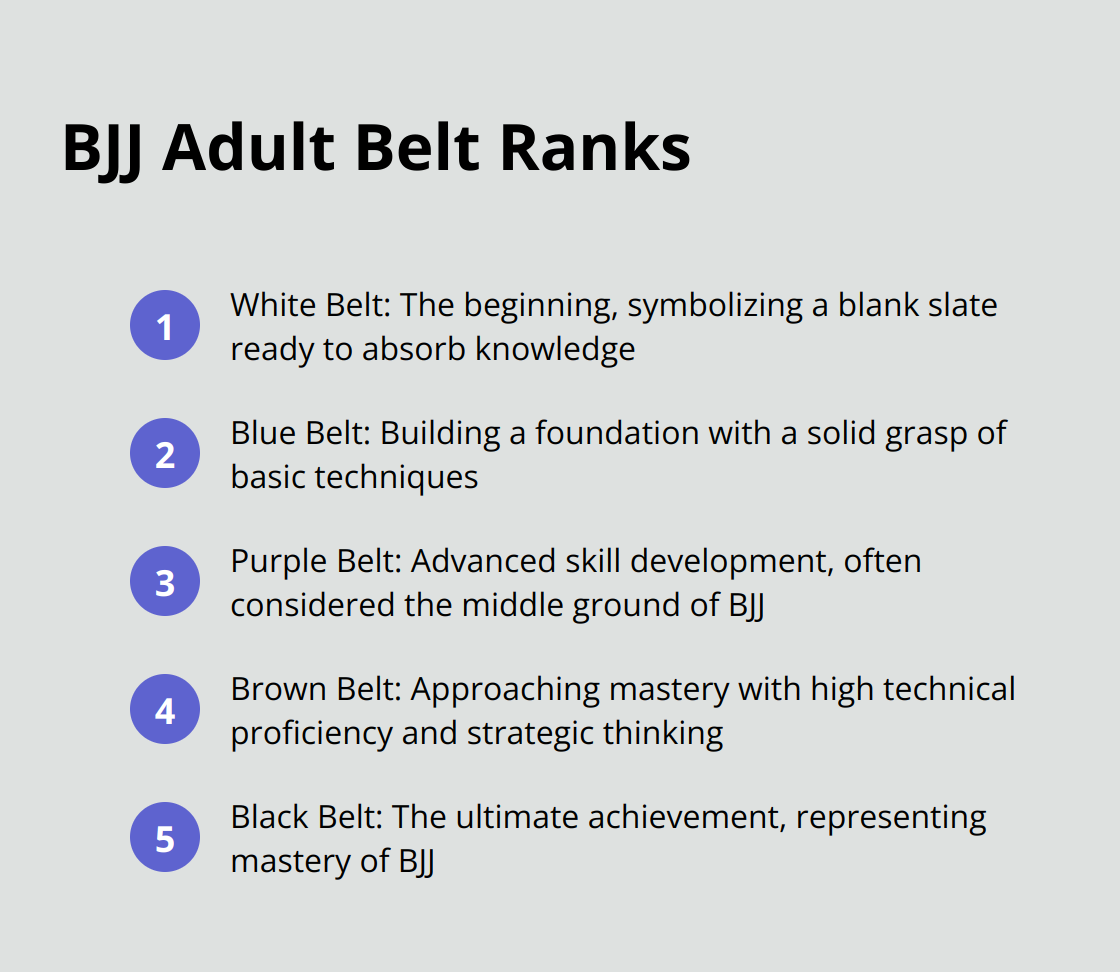At Jiu jitsu, we understand the importance of the Brazilian Jiu-Jitsu belt ranking system in a practitioner’s journey.
This system not only marks progress but also serves as a motivator for continuous improvement and dedication to the art.
In this post, we’ll break down how the ranking system works, from white to black belt, and explore the criteria for promotions.
The Belt Journey in Brazilian Jiu-Jitsu
Brazilian Jiu-Jitsu (BJJ) ranking system consists of several belt levels, each representing a different stage in a practitioner’s journey. The main adult belt ranks are:

White Belt: The Beginning
The white belt marks the start of every Brazilian Jiu-Jitsu (BJJ) practitioner’s journey. It symbolizes a blank slate, ready to absorb knowledge. At this stage, students focus on learning fundamental techniques and positions.
Blue Belt: Building a Foundation
Achieving a blue belt represents a major accomplishment. It signifies a solid grasp of basic techniques and the ability to apply them in sparring. Blue belts continue to refine their skills and develop a more strategic approach to rolling.
Purple Belt: Advanced Skill Development
Purple belt often stands as the middle ground of BJJ. At this level, practitioners demonstrate a deep understanding of techniques and start to develop their own style. Purple belts often take on teaching roles and compete at higher levels.
Brown Belt: Approaching Mastery
Brown belts showcase a high level of technical proficiency and strategic thinking. They often assist in teaching classes and mentor lower belts. Brown belts possess a comprehensive understanding of BJJ principles and applications.
Black Belt: The Ultimate Achievement
The black belt represents mastery of BJJ. Black belts continue to learn and refine their skills, often specializing in certain aspects of the art. They play a crucial role in preserving and advancing BJJ techniques and philosophy.
Consistent training and dedication prove paramount in progressing through the belt ranks. Regular attendance, active participation in classes, and a willingness to learn from both successes and failures serve as key factors in advancement. The belt system encompasses not just technical skills but also personal growth, discipline, and embodying the principles of BJJ both on and off the mat.
At Souza Grappling Co., we emphasize the importance of the journey rather than rushing through belt ranks. Our expert trainers provide guidance and support to help you progress at a pace that ensures solid skill development and a deep understanding of BJJ principles.
Now that we’ve explored the belt journey in BJJ, let’s examine the specific criteria used for belt promotions and how instructors evaluate a student’s readiness for advancement.
What Determines Belt Promotions in BJJ?
Technical Proficiency and Skill Mastery
At Souza Grappling Co., we assess a student’s ability to execute techniques with precision and effectiveness. This includes proper form, timing, and application in both drilling and live sparring situations. We expect students to demonstrate a comprehensive understanding of techniques appropriate for their current belt level and show progress in more advanced skills.

Attitude and Behavior
A student’s conduct both on and off the mat plays a significant role in their advancement. We value those who embody the principles of BJJ, showing respect, humility, and a willingness to help others. Positive attitudes, consistent attendance, and active participation in class discussions contribute to a student’s overall evaluation.
Competition Performance
While not mandatory, competition experience can accelerate a student’s progress. Successful performances in tournaments demonstrate the ability to apply techniques under pressure and showcase mental fortitude. However, we recognize that not all students choose to compete, and this does not hinder promotion opportunities.
Instructor’s Evaluation
Our instructors carefully weigh these factors when considering promotions. We don’t adhere to strict time frames, as each student’s journey is unique. Instead, we focus on consistent improvement and dedication to the art.
Personal Growth and Development
At Souza Grappling Co., we encourage students to focus on their personal growth rather than comparing themselves to others. The belt serves as a reflection of your journey. Our approach emphasizes the importance of continuous learning and self-improvement throughout one’s BJJ career.
As we move forward, let’s explore the significance of stripes within the belt system and how they contribute to a practitioner’s progression in Brazilian Jiu-Jitsu.
What Are Stripes in BJJ?
Purpose of Stripes
Brazilian Jiu Jitsu adopted a colored belt system to distinguish rank between students, following the example of Judo. Stripes in Brazilian Jiu-Jitsu (BJJ) serve as intermediate markers of progress within each belt level. These small white bands on the end of a practitioner’s belt provide tangible recognition of skill development and dedication. Stripes act as milestones between belt promotions, typically awarded in sets of four before a student becomes eligible for their next belt. This system allows for more frequent acknowledgment of a practitioner’s progress, which maintains motivation and enthusiasm throughout their BJJ journey.
Earning and Awarding Stripes
Instructors assess students’ performance regularly to determine stripe eligibility. Factors considered include technical proficiency, consistency in training, attitude, and overall improvement. Schools usually award stripes during formal ceremonies or at the end of regular classes (depending on the academy’s traditions). The process of earning stripes encourages students to focus on continuous improvement and provides clear goals to work towards.
Stripe Systems Across Schools
Stripe systems can vary between BJJ academies. While most schools follow the four-stripe system, some may use fewer or more stripes per belt. Some academies tie specific techniques or skills to each stripe, creating a more structured curriculum. Others take a more holistic approach, considering overall progress and improvement. This variation allows schools to tailor their approach to student development based on their teaching philosophy and student needs.
Stripes and Belt Promotions
Stripes help instructors gauge readiness for belt promotions. They provide a visual representation of a student’s progress within their current belt level. However, it’s important to note that stripes don’t guarantee automatic promotion to the next belt. Instructors still consider various factors (such as technical proficiency, attitude, and overall growth) when deciding on belt promotions.
The Value of Stripes in BJJ Training
Stripes offer more than just visual markers of progress. They can boost confidence, provide motivation during challenging periods, and foster a sense of accomplishment. For instructors, stripes offer a tool to track student development and provide timely feedback. This system creates a balanced approach to recognition in BJJ, acknowledging smaller steps of progress while maintaining the significance of belt promotions.

Final Thoughts
The Brazilian Jiu-Jitsu belt ranking system tracks progress and motivates practitioners throughout their journey. Each rank represents technical proficiency, personal growth, and dedication to BJJ principles. The addition of stripes within each belt level provides more frequent recognition, which helps maintain enthusiasm during the long periods between belt promotions.
Advancing through Brazilian Jiu-Jitsu belt ranks involves more than just time on the mat. It requires consistent training, a positive attitude, and a commitment to continuous learning. Instructors consider a holistic view of a student’s development when making promotion decisions (including technical skills, attitude, and overall growth).
At Souza Grappling Co., we emphasize the importance of focusing on the journey rather than fixating on belt colors. Our facility offers a supportive environment where practitioners can develop their skills in Jiu-Jitsu, Muay Thai, and self-defense, guided by expert trainers. We encourage our students to embrace each stage of their BJJ journey, recognizing that true mastery comes from dedication and perseverance.




